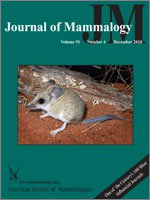Lower jaws (containing the teeth), eyes, and skin samples were collected from harp seals (Pagophilus groenlandicus) in the southeastern Barents Sea for the purpose of comparing age estimates obtained by 3 different methods, the traditional technique of counting growth layer groups (GLGs) in teeth and 2 novel approaches, aspartic acid racemization (AAR) in eye lens nuclei and telomere sequence analyses as a proxy for telomere length. A significant correlation between age estimates obtained using GLGs and AAR was found, whereas no correlation was found between GLGs and telomere length. An AAR rate (kAsp) of 0.00130/year ± 0.00005 SE and a D-enantiomer to L-enantiomer ratio at birth (D/L0 value) of 0.01933 ± 0.00048 SE were estimated by regression of D/L ratios against GLG ages from 25 animals (12 selected teeth that had high readability and 13 known-aged animals). AAR could prove to be useful, particularly for ageing older animals in species such as harp seals where difficulties in counting GLGs tend to increase with age. Age estimation by telomere length did not show any correlation with GLG ages and is not recommended for harp seals.
How to translate text using browser tools
16 December 2010
Harp seal ageing techniques—teeth, aspartic acid racemization, and telomere sequence analysis
Eva Garde,
Anne K. Frie,
Glenn Dunshea,
Steen H. Hansen,
Kit M. Kovacs,
Christian Lydersen
ACCESS THE FULL ARTICLE

Journal of Mammalogy
Vol. 91 • No. 6
December 2010
Vol. 91 • No. 6
December 2010
age determination
age estimation
amino acid racemization (AAR)
aspartic acid
eye lens
growth layer group (GLG)
Pagophilus groenlandicus




